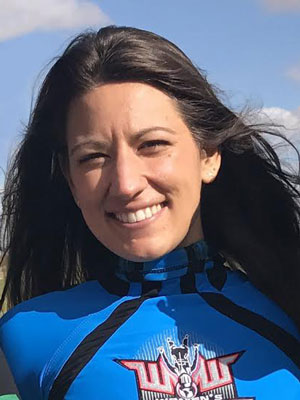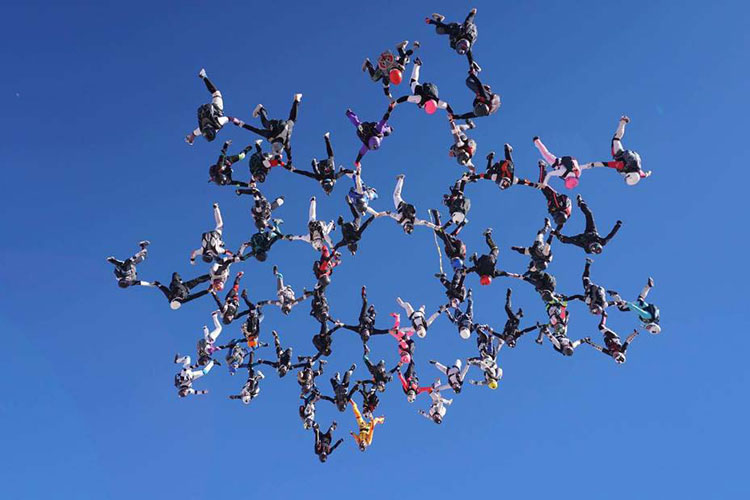Erin Ptaschinski copes with stress by plunging from planes into a 180-mph free fall before opening her parachute.
In the last six years, she’s skydived more than 1,800 times, but there’s one jump Ptaschinski, 31, a UC Berkeley adviser for undergraduate psychology majors, will never forget. That is, until she breaks her next world record.

Photo by Steve Curtis
Last month, Ptaschinski and 64 other fearless female skydivers jumped headfirst from a plane flying at nearly 20,000 feet above the Arizona desert and joined hands in upright positions, setting a world record in women’s vertical formation.
“We held the 65-way formation for 8.5 seconds,” says Ptaschinski, a Utah native and San Jose State graduate who joined UC Berkeley’s psychology department advising staff last year. “There was a sense of calmness during those few seconds and everyone was smiling. We knew we had it.”
Initially, about 90 female jumpers from around the world trained in Eloy, Arizona, for the vertical formation trial led by skydiving champion Amy Chmelecki. They braved sub-zero temperatures, turbulence, head kicks, blown sinuses and exhaustion to pull off their intricate pattern in the sky. Eventually, the number of skydivers was whittled down to 65, with Ptaschinski making the final cut.
At dawn on Sunday, Nov. 27, the weather was perfect, and all 65 skydivers took the plunge, forming a stunning show of airborne solidarity and winning the women’s world record for the largest sequential free fall formation.
It did not come easily.

Ptaschinski, an adviser to psychology majors, has been skydiving for six years. (Photos courtesy of Erin Ptaschinski)
“Everyone had to be focused and flying at their best ability since we only had a few seconds to complete the formation,” says Ptaschinski. “It took 16 attempts to break the record. It felt great to be surrounded by the best female skydivers in the world.”
Of course, Ptaschinski has had her share of inflight scares.
“As skydivers, we constantly review our emergency procedures before each jump, going over each step so we’re ready for any situation,” she says. “As a new skydiver, you’re constantly wondering when you’re going to have to cut away.”
It wasn’t until her 714th jump that she was forced to “cut away” or disconnect the main parachute due to a malfunction.
“I pulled my main parachute and it started spinning violently. I knew I was low to the ground and had to complete my emergency procedures fast,” she recalls. “My fight-or-flight response kicked in and I reminded myself not to panic, and that I knew exactly what to do.”
“I was able to get rid of my spinning parachute and pull my reserve handle and land safely,” she adds. “This cutaway experience not only made me a more confident skydiver, but assured me that I can take on any situation in the sky or on the ground.”
For these and other reasons, Ptaschinski is fully aware that skydiving is not everyone’s idea of a relaxing time.
“Not everyone wants to jump out of airplanes every weekend, plummeting to earth hoping their parachute opens. This sport draws a certain type of thrill-seeking, adventurous soul,” she says.
That said, “Because of these commonalities and the dangerous aspects of the sport, the community is especially close, and feels like family,” she adds.
And, in an era of great stress and uncertainly, the exhilaration of skydiving and letting go is therapeutic for Ptaschinski.
“Skydiving has taught me to live in the moment,” she says. “It forces me to be more aware of my surroundings and to be fully present in my life here on the ground.”
